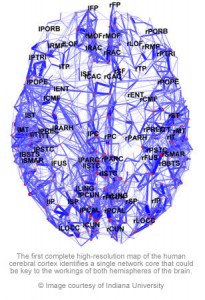 University of Utah medical researchers have uncovered a wiring diagram that shows how the brain pays attention to visual, cognitive, sensory, and motor cues. The research provides a critical foundation for the study of abnormalities in attention that can be seen in many brain disorders such as autism, schizophrenia, and attention deficit disorder.The study appears Nov. 1, 2010, online in the Proceedings of the National Academy of Sciences (PNAS).
University of Utah medical researchers have uncovered a wiring diagram that shows how the brain pays attention to visual, cognitive, sensory, and motor cues. The research provides a critical foundation for the study of abnormalities in attention that can be seen in many brain disorders such as autism, schizophrenia, and attention deficit disorder.The study appears Nov. 1, 2010, online in the Proceedings of the National Academy of Sciences (PNAS).
“This study is the first of its kind to show how the brain switches attention from one feature to the next,” says lead researcher Jeffery S. Anderson, M.D., Ph.D., U of U assistant professor of radiology. Anderson and his team used MRI to study a part of the brain known as the intraparietal sulcus. “The brain is organized into territories, sort of like a map of Europe. There are visual regions, regions that process sound and areas that process sensory and motor information. In between all these areas is the intraparietal sulcus, which is known to be a key area for processing attention,” Anderson says. “We discovered that the intraparietal sulcus contains a miniature map of all of these territories. We also found an organized pattern for how control regions of the brain connect to this map in the intraparietal sulcus. These connections help our brain switch its attention from one thing to another.”
In addition, scientists discovered that this miniature map of all the things one can pay attention to is reproduced in at least 13 other places in the brain. They found connections between these duplicate maps and the intraparietal sulcus. Each copy appears to do something different with the information. For instance, one map processes eye movements while another processes analytical information. This map of the world that allows us to pay attention may be a fundamental building block for how information is represented in the brain.
“The research uncovers how we can shift our attention to different things with precision,” says Anderson. “It’s a big step in understanding how we organize information. Furthermore, it has important implications for disease. There are several diseases or disorders where attention processing is off, such as autism, attention deficit disorder, and schizophrenia, among others. This research gives us the information to test theories and see what is abnormal. When we know what is wrong, we can talk about strategies for treatment or intervention.”
Deborah Yurgelun-Todd, Ph.D., professor of psychiatry in the U of U Schoold of Medicine and an investigator with the U of U Brain Institute and the Utah Science Technology and Research Initiative (USTAR), was the principal investigator and senior author of the study. The research was funded by a National Institutes of Health grant from the National Institute on Drug Abuse.
Source: University of Utah Health Sciences (2010, November 2). How brain is wired for attention.
